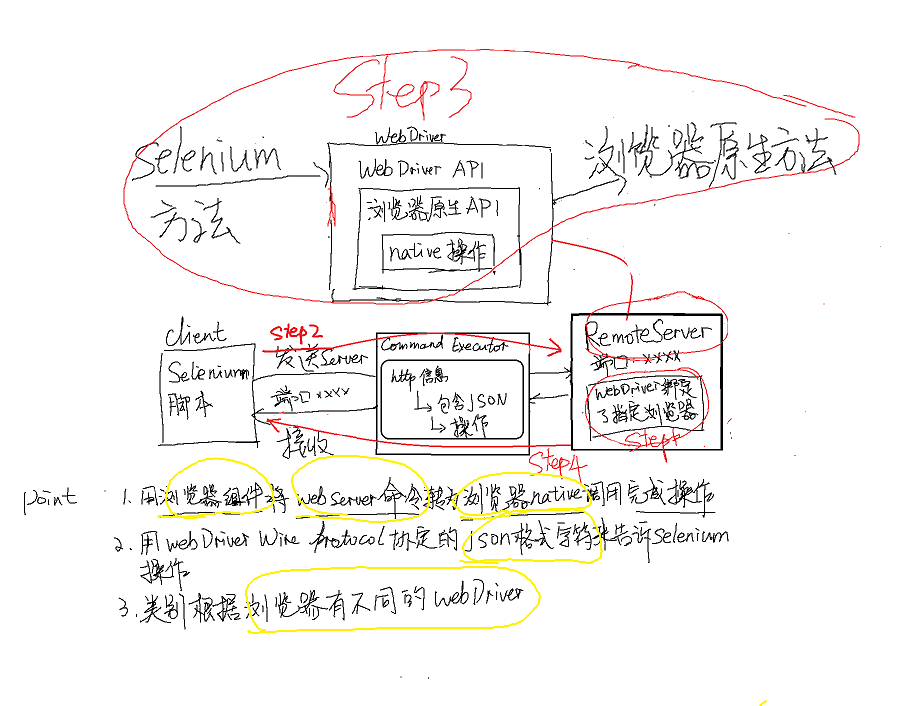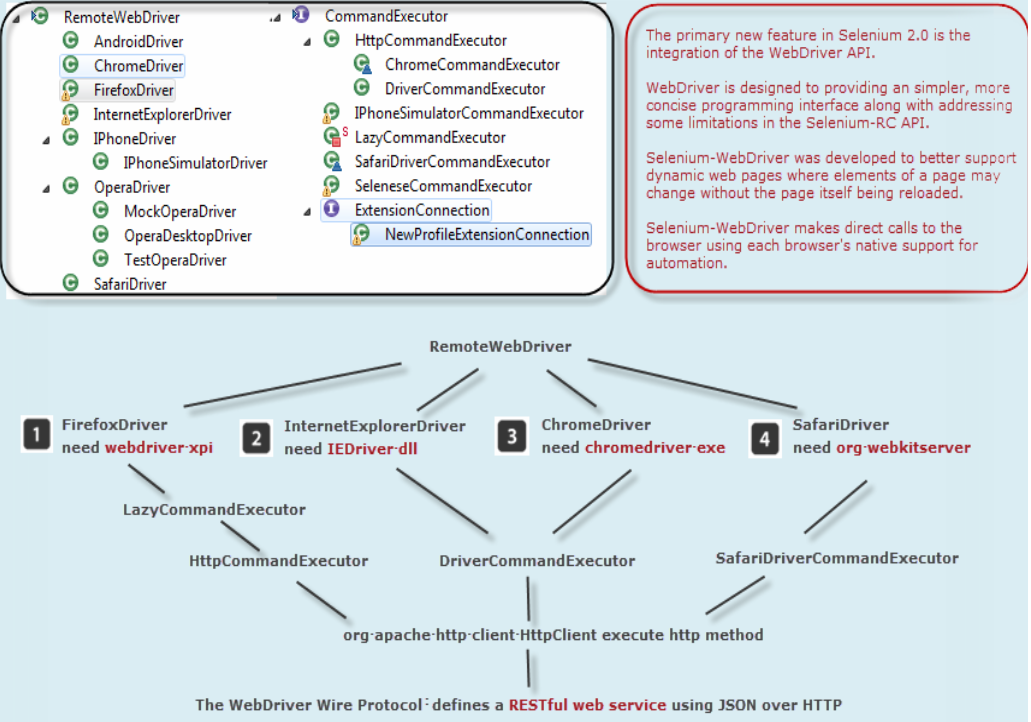昨天参加了公司的一个自动化测试的分享,有一些收获,记录一下。
1.主流的web端的UI自动化测试工具
基于浏览器API: selenium2.0,Watir(IE Driver)
基于JS 进行驱动:selenium1.0,sahi(ruby)
基于Windows GUI :QTP,AutoIt
2.实现原理(这里只列举第一种,第二种我没有实践,暂不研究)
基于浏览器API:

这里我在网上看了一下selenium2的实现原理,跟这个差不多。
参考:https://blog.csdn.net/ant_ren/article/details/7970793
selenium的工作原理:
1.用CS设计方式,将浏览器看作是remote server,有它自己的端口,将selenium的脚本执行端看作client。
2.client发送http request(操作放在json里面)发送给web server端,转化为浏览器的API,再封装成执行命令CommandExecutor ,发给浏览器去用native的操作执行
3.浏览器执行后,再返回给client
简化为:webdriver把浏览器的原生API包装了一下,通过conmmandExecutor来给浏览器发送http request请求(操作写在json里面),通过设置的端口,去请求浏览器,将发送的请求转化成浏览器的原生的命令,再将浏览器的返回,装进httpResponse里面,发回给客户端。
画了一张图

其他博客里面,引用的开发者的图

3.UI自动化的原则
- 不依赖环境,不改变环境
- 隔离变量和不变量
- 代码尽可能复用
4.使用的设计模式
三层:
- 界面表示层:一个页面封装到一个类中,一个方法对应一个控件,主要是查找控件,复杂控件操作,比如表格,需要再界面表示层实现
- 业务逻辑层:调用界面表示层的控件操作,完成业务逻辑,一般一个函数封装一个简单的业务操作。
- 测试用例层:调用业务层的函数完成测试,并验证结果,尽量不依赖环境,不破坏环境,不要直接调用界面层函数
5.源码解读,我用的是appium,不过appium和selenium是同源的,可以用来参考。
findElements代码
Response response = execute(DriverCommand.FIND_ELEMENTS,
ImmutableMap.of("using", by, "value", using));
@SuppressWarnings("unchecked")
protected List<WebElement> findElements(String by, String using) {
if (using == null) {
throw new IllegalArgumentException("Cannot find elements when the selector is null.");
}
Response response = execute(DriverCommand.FIND_ELEMENTS,
ImmutableMap.of("using", by, "value", using));
Object value = response.getValue();
List<WebElement> allElements;
try {
allElements = (List<WebElement>) value;
} catch (ClassCastException ex) {
throw new WebDriverException("Returned value cannot be converted to List<WebElement>: " + value, ex);
}
for (WebElement element : allElements) {
setFoundBy(this, element, by, using);
}
return allElements;
}
findElement 返回的是执行语句的 response,执行语句如下,返回值是response
protected Response execute(String driverCommand, Map<String, ?> parameters) {
Command command = new Command(sessionId, driverCommand, parameters);
Response response;
long start = System.currentTimeMillis();
String currentName = Thread.currentThread().getName();
Thread.currentThread().setName(
String.format("Forwarding %s on session %s to remote", driverCommand, sessionId));
try {
log(sessionId, command.getName(), command, When.BEFORE);
response = executor.execute(command);
log(sessionId, command.getName(), command, When.AFTER);
if (response == null) {
return null;
}
// Unwrap the response value by converting any JSON objects of the form
// {"ELEMENT": id} to RemoteWebElements.
Object value = converter.apply(response.getValue());
response.setValue(value);
} catch (SessionNotFoundException e){
throw e;
} catch (Exception e) {
log(sessionId, command.getName(), command, When.EXCEPTION);
String errorMessage = "Error communicating with the remote browser. " +
"It may have died.";
if (driverCommand.equals(DriverCommand.NEW_SESSION)) {
errorMessage = "Could not start a new session. Possible causes are " +
"invalid address of the remote server or browser start-up failure.";
}
UnreachableBrowserException ube = new UnreachableBrowserException(errorMessage, e);
if (getSessionId() != null) {
ube.addInfo(WebDriverException.SESSION_ID, getSessionId().toString());
}
if (getCapabilities() != null) {
ube.addInfo("Capabilities", getCapabilities().toString());
}
throw ube;
} finally {
Thread.currentThread().setName(currentName);
}
try {
errorHandler.throwIfResponseFailed(response, System.currentTimeMillis() - start);
} catch (WebDriverException ex) {
if (parameters != null && parameters.containsKey("using") && parameters.containsKey("value")) {
ex.addInfo(
"*** Element info",
String.format(
"{Using=%s, value=%s}",
parameters.get("using"),
parameters.get("value")));
}
ex.addInfo(WebDriverException.DRIVER_INFO, this.getClass().getName());
if (getSessionId() != null) {
ex.addInfo(WebDriverException.SESSION_ID, getSessionId().toString());
}
if (getCapabilities() != null) {
ex.addInfo("Capabilities", getCapabilities().toString());
}
Throwables.propagate(ex);
}
return response;
}
response的核心代码如下:执行command,然后用转化器将response的value转化成语句使用的代码
response = executor.execute(command);
……
Object value = converter.apply(response.getValue());
response.setValue(value);
这里的converter.apply,是JsonToWebElementConverter的方法,就是用来把返回的json串转化为element的转化器
public Object apply(Object result) {
if (result instanceof Collection<?>) {
Collection<?> results = (Collection<?>) result;
return Lists.newArrayList(Iterables.transform(results, this));
}
if (result instanceof Map<?, ?>) {
Map<?, ?> resultAsMap = (Map<?, ?>) result;
if (resultAsMap.containsKey("ELEMENT")) {
RemoteWebElement element = newRemoteWebElement();
element.setId(String.valueOf(resultAsMap.get("ELEMENT")));
element.setFileDetector(driver.getFileDetector());
return element;
} else if (resultAsMap.containsKey("element-6066-11e4-a52e-4f735466cecf")) {
RemoteWebElement element = newRemoteWebElement();
element.setId(String.valueOf(resultAsMap.get("element-6066-11e4-a52e-4f735466cecf")));
element.setFileDetector(driver.getFileDetector());
return element;
} else {
return Maps.transformValues(resultAsMap, this);
}
}
if (result instanceof Number) {
if (result instanceof Float || result instanceof Double) {
return ((Number) result).doubleValue();
}
return ((Number) result).longValue();
}
return result;
}
appium原理参考https://www.cnblogs.com/csj2018/p/9937511.html